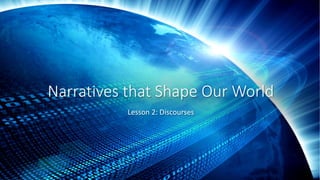
Narratives - Y11 - Lesson 2.pptx
- 1. Narratives that Shape Our World Lesson 2: Discourses
- 2. Glossary • Metanarrative n. • Marginalisation n. (marginalise v.) • Alterity n. • Discourse n. (dominant and oppositional) • Stigmatisation n. (stigmatise v.) • Subjugation n. (subjugate v.) • Hegemony n. (hegemonic adj.)
- 3. Writing Activity • Using an example from the TWO texts we explored yesterday, discuss how stories shape our understanding of the world around us. Aim for at least two examples from each text. • Challenge: Include at least two glossary terms (from previous slide) in your response. • The two texts we looked at were: • June Jordan – “Poem About My Rights” • Gordon Bennett – “Untitled”
- 4. Exemplar Response • Both June Jordan’s poem “Poem About My Rights” and Gordon Bennett’s “Untitled” artwork convey the power of metanarratives to curtail individual autonomy and dehumanise the marginalised. June Jordan’s use of polysyndeton in “I could not go and I could not think and I could not stay there” reinforces the interconnection between physical and psychological oppression and the destructive effect of dominant discourses on the Other. Additionally, the rhetorical question “who in the hell set things up like this” elucidates the socially constructed nature of this racist metanarrative and challenges the inevitability and absolutism of this unjust power dynamic. Gordon Bennett’s “Untitled” likewise reveals racist and colonialist metanarratives to negate the individuality and humanity of the marginalised, namely Indigenous Australians. Bennett’s repetition of panels that depict the historical representation of Indigenous people from a European gaze aligns with Jordan’s repetition of negative language to suggest the systemic nature of discrimination towards the Other. Furthermore, the gradual desaturation of the panels to complete black in the “Dismiss” panel clarifies the way in which the marginalised are silenced by the dominant discourse by depriving them of authority and agency. Thus, this poem and artwork compellingly demonstrate how narratives about the inferiority of the marginalised lead to them being alienated from society and eventually dismissed.
- 5. What is a Discourse? • Here are some categories of language that are used in our culture. For each one, write down who is qualified to speak this language, who it will be spoken to, where it will be spoken, and what objects will be spoken about. • Medical Language (speaker? Hearer? Place? Object?) • Legal language (speaker? Hearer? Place? Object?) • Literary language (speaker? Hearer? Place? Object?) • Religious language (speaker? Hearer? Place? Object?)
- 6. What is a Discourse? Continued… • All areas of human activity have their own ‘languages’. These ‘languages’ include not only terms and concepts but also ways of speaking. These categories of language are called discourses. The philosopher Michel Foucault has argued that discourses operate according to unwritten rules about who can speak, who is spoken to, and what kinds of things can be talked about. They also involve certain relations of power, as the examples before show. • Discourses do not offer neutral descriptions of the world. They represent the world from certain viewpoints. They also compete with each other for control of certain aspects of life. Wherever we find one discourse, we know that it is taking the place of another which could be there. For example, where Western cultures speak of ‘mental illness’ it was once possible to speak of ‘possession’. This change has been due in part to the fact that mental illness has become a subject of medical discourse rather than a subject of religious discourse. In simple terms, this might show a movement of power from priests to doctors.
- 7. Dominant and Oppositional Discourses • Discourses which operate from positions of power are sometimes referred to as dominant discourses. Those which seek to operate from other positions are alternative or oppositional discourses. Literary texts can bear traces of many different and competing discourses, but in the processes of reading and writing, dominant discourses tend to obscure alternative and oppositional forms. In this way, texts and readings privilege some views of the world over others, and basic contradictions are hidden. By teasing out the discourses of a text, and observing which ones seem to be privileged, we can find out which views a text supports.
- 8. Focus Questions How is storytelling a universal element of human experience? How and why do stories resonate with their audiences across time? What are the conventions of narrative and how are they crafted to tell stories about the other? How do narratives about ‘the other’ comment upon and reflect their own contexts? How do narratives about ‘the other’ shape our perceptions of our world, and challenge existing structures and practices? How can narratives support or challenge the authority of the dominant culture?